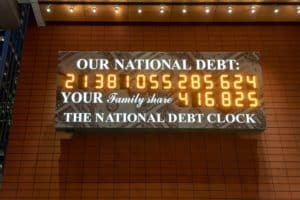
In the postwar period through 2019, the federal government borrowed an average of 2.1% of GDP each year.
With a $1.1 trillion deficit projected before the pandemic, $2.4 trillion of new spending, and a steep drop in near-term revenues from a shrinking economy, the federal government is set to borrow 20% of GDP in 2020.
The Committee for a Responsible Budget projects that federal debt held by the public will exceed the size of the economy by the end of 2020 and eclipse the prior record set after World War II by 2023.
The United States' debt is on an unsustainable path...
U.S. federal debt relative to GDP has gone from 35% in 1980 to 55% in 2000 to reach 110% in 2020.
Are we seemingly headed towards the Japanese model? Japan has borrowed more heavily than most developed countries in recent years, with a debt-to-GDP ratio before the pandemic of nearly 230%.
While Japanese interest rates and inflation remained steady, this debt load has led to a record of anemic growth.
In addition, $6.9 trillion of America’s $23 trillion of total federal debt is held by foreign countries with China holding 5%.
While historically low interest rates are making this debt load manageable with interest on the debt of $375 billion in 2019, a spike in interest rates would be another kettle of fish altogether.
Using projections by the Congressional Budget Office (CBO) and assuming annual economic growth rates of 2.4% for the next decade would imply the federal national debt rising to between $35 trillion and $38 trillion by 2030.
This would represent between 135% and 145% of 2030 GDP.
Please take special note… Medicare, Medicaid and Social Security account for about half of annual federal spending.
Of the 330 million Americans, 60 million are on Medicare, 77 million on Medicaid and 36 million receive food stamp assistance.
The Congressional Budget Office projects that total federal spending in the decade of 2020–2030 will be a whopping $62.7 trillion.
On top of this, we had a leading Democratic nominee calling for “Medicare for All” that, if implemented, would over the 2020s increase the financial size of America’s federal government by roughly 100%.
The main culprit is the runaway costs of healthcare from 2008–2018. Government's historical decisions and thereof enactment always finds itself vulnerably positioned well into the future for future Government administrations to manage.
This increased 97.4% — rising at more than double the rate of general price inflation, and also resulting in an explosion of healthcare workers reaching over 20 million.
Can you imagine what these numbers will be when the dust settles on COVID-19 coronavirus?
It wouldn’t surprise me if the total federal and state cost of COVID-19 explodes to more than $10 trillion. Think about that number.
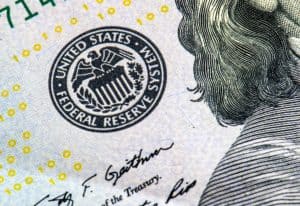
For most Americans, the actions of the Federal Reserve System (usually referred to as the Fed) are a bit of a mystery. It seems to act in the shadows and have a language and jargon all its own.
As you might already know, the Fed is the United States' central bank.
In short, it's a bank for the country's private banks, and its mission is to make sure the financial and banking systems stay on track so business and commerce can operate in a normal way. Traditionally, it’s goal has been to regulate interest rates and seek a balance between inflation, growth and employment.
This has changed since the global financial crisis of 2008–2009 when it played a much more pro-active role in providing liquidity by buying up all sorts of government as well as corporate bonds.
The most direct beneficiary of its crisis-mode, super-charged agenda is the stock market.
For the coronavirus rescue effort, the Fed has really fired the bazooka more than once and stands ready with more ammunition as needed or when necessary.
Among the initiatives is a commitment to continue its asset purchasing program “in the amounts needed to support smooth market functioning and effective transmission of monetary policy to broader financial conditions and the economy,” according to Fed Chairman Jay Powell.
The Federal Reserve is also moving for the first time into corporate bonds, purchasing the investment-grade securities in primary and secondary markets as well as exchange-traded funds.
The Fed’s repo operations, through which it provides banks short-term funding, is being offered at an interest rate of zero.
The central bank’s balance sheet, which consists largely of bonds and other assets it has purchased over the years, ballooned to $5.3 trillion and as I have already mentioned, could balloon to a staggering $10 trillion.
That’s well above the $4.5 trillion peak it hit in mid-May 2016, before the Fed started rolling off the bonds it had acquired during and after the Great Recession.
This latest peak has occurred in just a blink of an eye — the result of expansion begun in small steps earlier this year and then accelerated with the growth of the COVID-19 coronavirus crisis.
The Fed is an unelected institution that serves at the pleasure of the president, and its new programs have paved the way for its spending powers to be significantly expanded and politicized.
"America has never seen anything like it," said Peter Conti-Brown, a nonresident fellow at the Brookings Institution.
Critics have worried about the possibility of inflation resulting from all that extra cash in the system, though it hasn’t been a problem since the asset purchases really started in late 2008.
Markets seem to be accepting that the 2008 experience, when the Fed’s balance sheet exploded without inflation taking effect, will repeat itself into 2020 and beyond.
Will this assumption based on past history be correct? Why could it be different this time and how can investors hedge these risks?
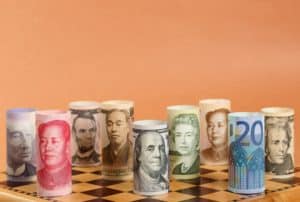
America’s greatest competitive edge in the world and over rival China is the dominance of the U.S. dollar in trade and finance. The dollar is often referred to as "the world's reserve currency."
Trades involving the U.S. dollar reached over $5.8 trillion per day in 2019, putting the dollar on one side of more than 88% of all foreign exchange transactions. This is huge.
The U.S. dollar has dominated the international economy for decades based on the large size and relative stability of the U.S. economy as well as its advanced and open financial markets.
Governments and businesses around the world view the U.S. dollar as a safe store of value and as the best bridge for transactions between less internationalized currencies. This also gives America leverage in terms of sanctions and supercharges U.S. economic policies' total impact on the global economy.
As you might expect, the euro, which is used by hundreds of millions of people across 19 euro area countries, is the second most traded currency. The yen is the third most exchanged currency in the world and by far the most used Asian currency, despite China boasting total trade values more than three times greater than those of Japan.
Just how is the Chinese renminbi (also referred to as the yuan) doing?
According to the IMF, it represented just 4% of trade.
And of the roughly $11 trillion in allocated foreign exchange reserves held by countries around the world in 2019, just under 2% were denominated in renminbi. In sharp contrast, 60% of world reserves remain in U.S. dollars and 20% in euros. These numbers are meaningful!
Beijing is handicapped by having relatively undeveloped capital markets to work with and they also need to deal with tight capital controls to buffer the Chinese economy against domestic and global instability.
These restrictions impede the free movement of the renminbi, making it ultimately less attractive as an international currency.
But America should not take dominance of the dollar for granted, as history shows that this edge can end abruptly if the world loses confidence in a country or a dominant world currency.
Too much debt and economic or political instability can open the door for competitors to move in. And there is constant chatter of China making a dramatic move that might include somehow backing its currency with gold, or launching a killer digital currency backed by gold, further supported by the yuan itself.
This begs the question as to how to hedge the U.S. dollar to a world competing currency right now.
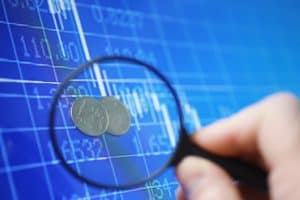
Let's look at what makes a country's currency a good hedge and safe haven in times of stress:
Its currency should demonstrate deep liquidity so that investors can move in and out of it without sharp movements in price. It needs to be widely recognized as a reserve currency wordwide.
The fiscal discipline and political stability of the country needs to be unquestioned. Countries with large fiscal deficits are unable to be dependable safe havens since the path of least resistance is to devalue the currency to make debt loads more manageable.
Investors and trading partners thrive best in a market-oriented economy where the rules are clear and transparent. Faith in the fairness of the judicial system and institutions is vitally important.
Switzerland and the Swiss franc fit the bill nicely.
For starters, Switzerland is home to four of the largest five firms in Europe in terms of market value: UBS (NYSE: UBS), Nestlé (OTC US: NSRGY), Novartis (NYSE: NVS) and Roche (OTC US: RHHBY). These companies are increasingly tapping into emerging market growth.
It also has the highest per capita income in the world...
While only 137 miles by 216 miles in size, with a population of 7.2 million, Switzerland packs a punch and is a financial and multinational powerhouse.
The Swiss franc is backed by ample gold reserves, fiscal discipline, a trade surplus and very little foreign debt.
Outward looking, Switzerland has 40% of its gross domestic product attributed to exports. Booming pharmaceutical exports increased its merchandise trade surplus 20% in 2019 according to the Swiss customs office.
Switzerland represents the third-largest financial center in the world after New York and London. It is also home to world-beating pharmaceutical, engineering and food companies
Switzerland enjoys a stable government, vibrant democracy and a reputation as an asset haven in times of stress.
The Swiss have had a functioning democracy for 500 years and actually have a fairly weak central government, with a legislature that meets for only two weeks, four times a year (good idea for U.S. Congress?). Voters actually defeated a referendum that would have implemented a shorter workweek and longer vacations.
All men between the ages of 20 and 42 are required to engage in military training each summer, resulting in an army of 625,000. Swiss guards have protected the Vatican since 1506.
This all sounds pretty good doesn’t it?
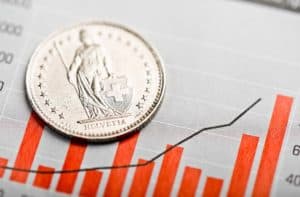
Switzerland is home to a number of blue chip global multinational companies with entrenched brand names, dominant market shares, proven management teams, solid free cash flows and double-digit growth potential.
The iShares Switzerland (NYSE: EWL) is a wonderful way to gain exposure to a basket of Switzerland’s leading multinationals and has an expense ratio of only 0.59%.
In addition, Swiss equities are on sale, trading collectively at only 11 times earning while the S&P 500 is at 16 times and India is at 22 times earnings. The rising Swiss franc puts pricing pressure on Swiss exporters but a strong Swiss franc supercharges returns for investors in EWL.
My favorite stock pick is Nestlé (OTC US: NSRGY). This consumer giant has a share-buyback program, a focus on growth in emerging consumer markets and a rising dividend.
ABB (NYSE: ABB) is a terrific infrastructure play and has been on a tear, winning power and automation-technology contacts all over the world.
And if you want only exposure to the Swiss franc, take a look at the CurrencyShares Swiss Franc Trust (NYSE: FXF).
You may wish to pair EWL with iShares Singapore (NYSE: EWS). Singapore is the “Switzerland of Asia” with $40,000 of foreign exchange reserves for every citizen. This is a bit higher risk and more of a value play since the Singapore economy has slowed a bit but its financial discipline and political stability is still first class.
As a hedge on the potential weakening of the U.S. dollar and as a haven from the financial storm rattling the windows of the world, you can’t go wrong buying Swiss quality.

Carl Delfeld, Contributor
for Investors News Service
P.S. To discover more opportunities in the hottest sectors in North America, sign up now to the Financial News Now newsletter to get the latest updates and investment ideas directly in your inbox!
DISCLAIMER: Investing in any securities is highly speculative. Please be sure to always do your own due diligence before making any investment decisions. Read our full disclaimer here.
Guide to Investing in Gold & Silver, by Michael Maloney
The Black Swan: The Impact of the Highly Improbable by Nassim Nicholas Taleb
Inflation & Deflation, Their Causes and Effects by Kimberly Amadeo, The Balance, November 9, 2018
https://www.cnbc.com/2020/03/27/the-feds-balance-sheet-just-passed-5-trillion-for-the-first-time-ever.html
https://www.cnbc.com/2020/03/23/fed-announces-a-slew-of-new-programs-to-help-markets-including-open-ended-asset-purchases.html
https://www.federalreserve.gov/monetarypolicy.htm
https://www.wsj.com/articles/charlie-munger-the-phone-is-not-ringing-off-the-hook-11587132006
WSJ, April 13, 2020